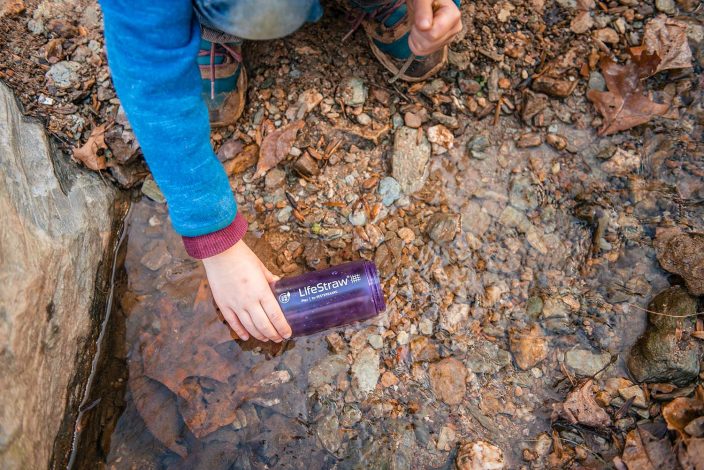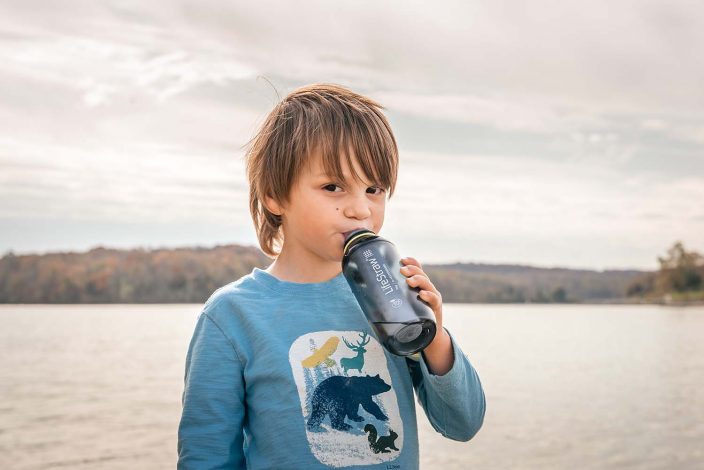Tips for Staying Properly Hydrated on the Hiking Trail
- Blog Tips for Staying Properly Hydrated on the Hiking Trail
While the kids in our lives may consider our constant reminders to drink more water an annoying form of nagging, we have the science to back us up. Water makes up about 60 percent of an adult human body, making proper hydration crucial for body systems to function properly. Exercising can deplete this percentage quickly, leaving you feeling tired, dizzy, and even nauseous if you don’t drink enough fluids to replenish what you lose. But how much water do adults and kids need while participating in an exercise such as hiking? Here we will discuss how much water kids and adults need while exercising and provide tips for staying hydrated on the trail. 
How much water do you need?
There are a number of factors that determine the appropriate amount of water needed to stay hydrated while being active. These include age, exercise intensity, duration of exercise, weather, and even your body type. In general, an adult needs about half a liter of water every hour during moderate exercise in moderate temperatures. According to WebMD, toddlers need to drink about 2-4 cups of water per day, and 4-8 year olds drink about 5 cups of water per day. When active, they will need about 2-3 cups more before and after the activity. When temperature, duration, humidity or altitude increase, more water is needed to sustain the body.
Trail Hydration Tips:
Make water available and convenient
If your water is shoved into the bottom of your pack, you are less likely to reach for it until you are really feeling thirsty. Keep water close at hand by using the mesh pockets on the side of most hiking packs, clipping it close by with a carabiner, or using a hydration reservoir. If they are able, have children carry their own water so they don’t need to constantly ask you for a drink. A kid-size bottle with a built-in filter is the perfect size for small hands and small hiking packs. We like the size and shape of the Lifestraw Play Filter Water Bottle.
Pre-hydrate
This is especially important for longer hikes and hot days. Drinking plenty of water the night before and morning of a hike can ensure that you start out well-hydrated and ready for your adventure.
Lighten the load
Choosing a trail that provides a water source, such as a creek or lake, means you can refill your water without having to haul more with you. Be sure to choose a durable water bottle with a built-in filtration device to ensure clean water straight from the source. The Lifestraw Go Filter Water Bottle is a great option to remove bacteria, parasites, microplastics, chlorine, and organic chemical matter. If heavy metals are also an issue in your area, consider the advanced filtration technology of the Lifewstraw Flex or the Lifestraw Play Bottle or kids.
Drink often
Rather than waiting until you feel thirsty (or waiting for the “I’m thirsty!” complaints from your kiddos), sipping on water often throughout a hike can ensure that you stay hydrated. Once you feel thirsty, you are already moving towards dehydration!

Don’t forget about altitude!
Your body loses water via respiration approximately twice as fast at higher altitudes, so be sure to drink more when hiking at higher elevations!
Signs and Symptoms of Dehydration
While prevention is key, knowing the signs of dehydration is important in order to counteract the effects quickly. Early signs include thirst, decreased energy, and dry mouth. As dehydration sets in, more serious symptoms show up. These include headaches, muscle cramps, nausea, confusion, irritability, and less frequent urination. If any of these symptoms are present, it’s important to stop activity, find a shady spot to sit and relax, rehydrate with water, and cool down body temperature. Checking in with your kiddos often, and yes, “nagging” them, to make sure they are drinking plenty of water can mean the difference between a fun family adventure and a scary situation! For more information and expert advice on the prevention and treatment of dehydration for adults and kids of all ages, check out this article.
ABOUT HIKE IT BABY
Hike it Baby is a 501(c)(3) non-profit organization dedicated to getting families outdoors and on trails across the U.S. and internationally, supporting, educating and inspiring families through their more than 300 communities across North America. Since its grassroots inception in 2013 in Portland, Oregon, Hike it Baby is now a growing community of 270,000 families and 500 volunteer branch ambassadors hosting more than 1,600 hikes per month. More information, as well as daily hike schedules, can be found at HikeitBaby.com, Facebook, YouTube, Pinterest, and Instagram. Images courtesy of Jessica Human.
Related Content




Comments